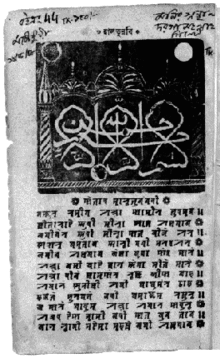Muhammad Sadeq Ali Munsif | |
|---|---|
 Halat-un-Nabi by Sadeq Ali | |
| Native name | সাদেক আলী |
| Born | Shree Gour Kishore Sen 1798 or 1801 |
| Died | 1862 (aged 63–64) |
| Occupation | Munshi, judge, poet |
| Language | Dobhashi Bengali |
| Genre | Islam |
| Notable works |
|
Munshi Muhammad Sadeq Ali (Bengali: মোহাম্মদ সাদেক আলী, Nagri: ꠍꠣꠖꠇ ꠀꠟꠤ), born as Sri Gaur Kishore Sen (Bengali: শ্রী গৌর কিশোর সেন), was a prominent Dobhashi Bengali writer, poet and district judge from 19th century Bengal.[1] He is considered to be the most well-known writer to have used the Sylheti Nagri script and this is due to his magnum opus, Halat-un-Nabi (condition of the Prophet),[2] which gained immense popularity in the Sylhet region and would later be transcribed in the Bengali script.[3]
Early life
Shree Gour Kishore Sen was born in a Bengali Baidya family around 1800.[4]
In August 1818, he was taught the basics of Islam by Maulvi Muhammad Yusuf. Sen grew an interest in the Arabic and Persian languages, and so he studied under Mir Munshi Abul Fazl, a detective of the Hingazia thana.[2]
He formally accepted Islam and changed his name to Sadeq Ali. He also mentions that he was a follower of the Hanafi madhhab.[2]
Career as a writer
ꠉꠚꠥꠞ ꠞꠢꠤꠝ ꠀꠟ꠆ꠟꠣ ꠇꠣꠖꠤꠞ ꠍꠥꠛꠢꠣꠘ
gôfur rôhim alla qadir subôhan
Glorified is the Oft-Forgiving, Most Merciful Allah, The Able
ꠍꠤꠔꠣꠞꠣꠄ ꠈꠥꠛꠤ ꠖꠤꠟꠣ ꠡꠣꠔ ꠀꠍꠝꠣꠘ
sitarae khubi dila shat asman
With stars, He beautified the seven heavens
ꠏꠝꠤꠘꠦꠞ ꠈꠥꠛꠤ ꠖꠤꠟꠣ ꠇꠔ ꠌꠤꠎꠦ ꠀꠞ
zôminer khubi dila kôtô chize ar
With many things, He beautified the earth
ꠡꠇꠟ ꠝꠢꠔꠣꠎ ꠈꠣꠟꠤ ꠉꠘꠤ ꠙꠞꠅꠀꠞ
shôkôl môhôtaj khali gôni pôroar
We are all needy except the All-Sufficient Provider
– First stanza - Munshi Sadeq Ali[4]
Sadeq Ali decided to take a reformist stance against the common Sylheti Muslim literature which had used religious syncretism with Hinduism, in particular Vaishnavism, and Sufi Baul elements. Sadeq Ali then published his Mahabbatnama based on the story of Yusuf and Zulaikha taking inspiration from the earlier version by Shah Gharibullah of West Bengal.[5] He also wrote Hashor Michhil (Procession of Hashr), which also remains in circulation, continuing to be sold in shops in both Sylheti Nagri and Bengali scripts. as well as Radd al-Hind (Response to the Hindus), Kashf al-Bid'ah (Unveiling of Innovation), Pandenama, Dafeh al-Hujat, Hushiarnama and Rahasatul Islam.[5]
Sadeq Ali later composed another puthi about the prophetic biography called Halat-un-Nabi in 1855, focusing more on scripture rather than more popular folk beliefs. It became a household item in every Bengali Muslim homestead in Greater Sylhet and Cachar, making it the most popular and widely printed book in the Sylheti Nagri script.[3] Sadeq Ali wrote Radd-i-Kufr in 1874.[6]
Death and legacy
Long after Sadeq Ali's death in 1862,[5] the Bangladesh Liberation War took place in 1971. A fire took place in Bandar Bazar, Sylhet town destroying the Islamia Press, which was the largest Sylheti Nagri printing press. However, Bengali script versions of the Halat-un-Nabi puthi continued to be in production and circulation.[7] The puthi was included in the Nagri Grantha Sambhar, a selection of Nagri puthis published by Utsho Prokashon in 2014.[8][9]
See also
References
- ↑ Sadiq, Mohammad (December 2008). Sileṭi nāgrī: fakiri dhārār fasal সিলেটি নাগরী: ফকিরি ধারার ফসল (in Bengali). Dhaka: Asiatic Society of Bangladesh. OCLC 495614347.
- 1 2 3 d’Hubert, Thibaut. "The khādim and the munshī: Śāh Garībullāh and Sādek Ālī". Foundational Maḥabbat-nāmas: Jāmī's Yūsuf u Zulaykhā in Bengal (ca. 16th–19th AD) (Thesis).
- 1 2 Bhuiya, Md. Abdul Musabbir (2000). Jalalabadi Nagri: A Unique Script & Literature of Sylheti Bangla. Badarpur, Assam: National Publishers.
- 1 2 "Puthi Halot-un-Nobi by Sadek Ali". Sylheti Translation and Research.
- 1 2 3 Saleem, Mustafa (30 November 2018). মহব্বত নামা : ফার্সি থেকে বাংলা আখ্যান. Bhorer Kagoj (in Bengali).
- ↑ Ahmed, Rafiuddin (1988) [First published in 1981]. The Bengal Muslims 1871-1906: A Quest for Identity (2nd ed.). Oxford University Press. p. 253. SBN 19-562203-0.
- ↑ Kane, David Michael (2008). Puthi-Pora: 'Melodic Reading' and its Use in the Islamisation of Bengal (Thesis). School of Oriental & African Studies. S2CID 158262463.
- ↑ "নাগরী লিপির গ্রন্থসম্ভার নিয়ে এল উত্স প্রকাশন" [Utsho Prokashon has come with a Nagri script book collection]. The Daily Ittefaq (in Bengali). 23 January 2014. Retrieved 7 February 2021.
- ↑ "একুশের আবহ". Samakal (in Bengali). 23 January 2014. Retrieved 7 February 2021.